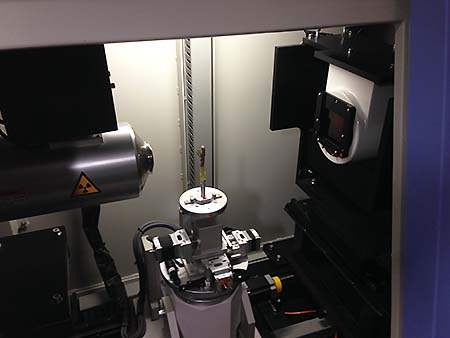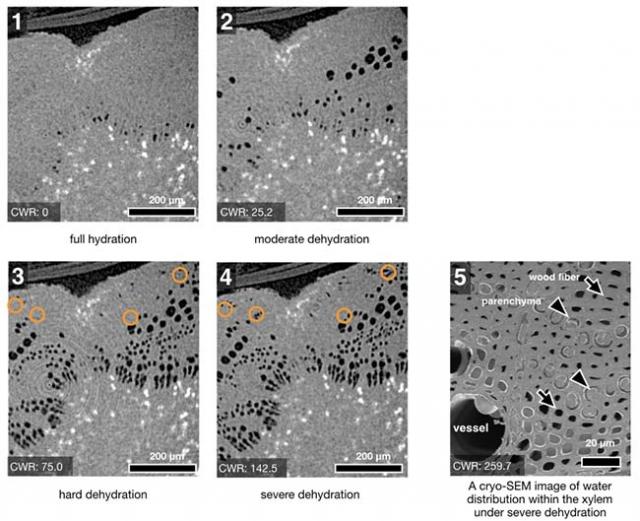Home > Research > Research Results > Research Results 2020 > Vessels inside broadleaved trees attempt to store water without relying on surrounding cells
Update:September 16, 2020
Main content starts here.
Vessels inside broadleaved trees attempt to store water without relying on surrounding cells
| Article title |
Imperforate tracheary elements and vessels alleviate xylem tension under severe dehydration: insights from water release curves for excised twigs of three tree species |
|---|---|
| Author (affiliation) |
Kenichi Yazaki (a), Delphis F Levia (b), Akiko Takenouchi (c), Makoto Watanabe (c), Daisuke Kabeya (d), Naoko H Miki (e), Haruhiko Taneda (f), Mayumi Y Ogasa (g), Michio Oguro (h), Shin-taro Saiki (d), Hiroyuki Tobita (d), Kenji Fukuda (f) (a) Hokkaido Research Center, FFPRI, Sapporo, Hokkaido, Japan. (b) University of Delaware, Newark, Delaware, USA. (c) National Institute of Materials Science (NIMS), Tsukuba, Ibaraki, Japan. (d) Department of Plant Ecology, FFPRI, Tsukuba, Ibaraki, Japan. (e) Okayama University, Okayama, Japan. (f) The University of Tokyo, Bunkyo-ku, Tokyo, Japan. (g) Kansai Research Center, FFPRI, Kyoto, Japan. (h) Department of Forest Vegetation, FFPRI, Tsukuba, Ibaraki, Japan. |
| Publication Journal |
American Journal of Botany, August 2020 DOI:10.1002/ajb2.1518( External link ) |
| Content introduction |
Understanding how trees withstand dehydration is important for such things as increasing the survival rate of seedlings during planting and estimating forest dynamics under fluctuating climatic conditions. In the xylem of trees, vessels are conduits for water, but when water in vessels is cut off during water shortages, water cannot reach leaves above that. In studies made so far, it has been theorized that to prevent water inside vessels during water shortages from being cut off, water is transferred in stages, first from wood fiber cells around the vessels, and then from parenchyma cells, in order to fill the vessels with water. To examine this theory, X-ray CT and a cryo–scanning electron microscope were used to directly observe water inside cut twigs of Quercus serrata (konara oak, ring-porous) and Cercidiphyllum japonicum (katsura tree, diffuse-porous) in order to study how easily water in cells is lost during water shortages. As a result, water remained in vessels even when dehydration proceeded to a certain extent, but when dehydration further progressed after that, water was removed, first in vessels and then in wood fiber. In contrast, parenchyma cells continued to store water, even when other cells had become dehydrated. This indicated that, unlike in previous theories, water in wood fiber and parenchyma cells did not move to vessels, even during water shortages. The present study has revealed the previously unknown relationship between xylem and water storage capacity. The results will provide important scientific information for evaluating the ability of various tree species to withstand dehydration. Notes: vessel: a dead cell that conducts water from the root system to the leaves. wood fiver: a dead cell that provides structural support to the stem and branches. parenchyma: a living cell within the xylem that has the function of storing carbohydrate. ring-porous: a type of wood structure having larger vessels located along the annual ring border in the transverse plane. diffuse-porous: a type of wood structure having vessels diffused within the xylem in the transverse plane.
The black areas are vessels from which water has drained. As dehydration progresses (1→4) water is removed from the vessels, but even in the daytime when dehydration is particularly intensive, water remains in small vessels (3-4, red circles). Furthermore, as drying continues, water drains from wood fiber cells (5, arrows), but remains in parenchyma cells (5, arrowheads). CWR: Cumulative water release per unit volume |
Copyright © Forest Research and Management Organization. All rights reserved.


